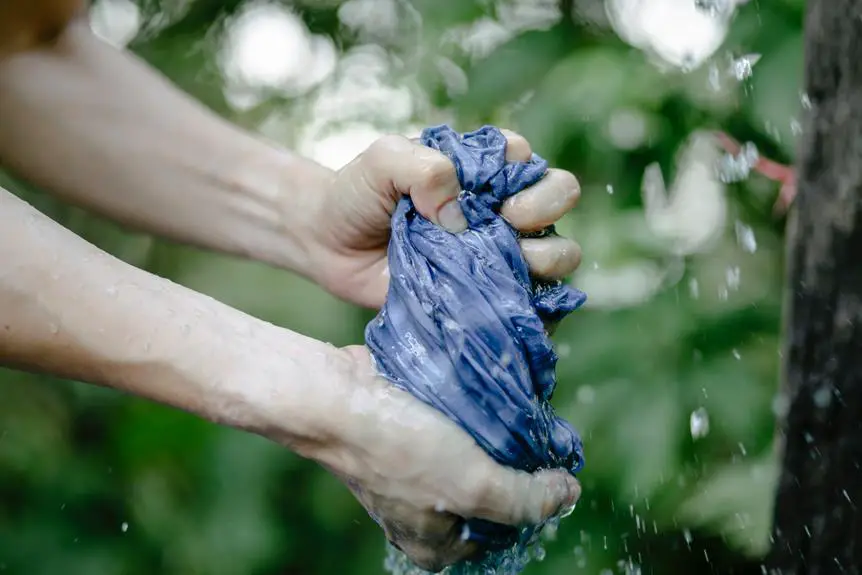If you're ready to dive into the colorful world of fabric dyeing, the hot water method for dyeing synthetic fabric is like adding a burst of vibrant hues to a blank canvas.
This technique allows you to transform your synthetic garments or fabrics and make them truly your own.
With the right materials and a few simple steps, you can master the art of dyeing synthetic fabric with hot water.
From choosing the perfect dye to rinsing and drying your newly transformed fabric, this method offers you the mastery you crave.
Let's get started on this exciting journey of adding a personal touch to your synthetic textiles.
Key Takeaways
- Choose a dye specifically formulated for synthetic fibers
- Wash the fabric in hot water with a mild detergent before dyeing
- Follow the dye manufacturer's instructions for the correct dye-to-water ratio
- Rinse the fabric thoroughly with cold water after dyeing
Choosing the Right Dye
You should start by selecting a dye that will adhere to synthetic fabric effectively. When choosing the right dye for synthetic fabrics, it's crucial to consider the type of material you're working with and the color fastness requirements.
Look for a dye specifically formulated for synthetic fibers, as these dyes are designed to bond well with materials like polyester, nylon, and acrylic. Additionally, consider the color fastness requirements of the fabric.
If the fabric will be exposed to sunlight or frequent washing, opt for a dye that offers excellent color retention and resistance to fading. It's essential to carefully read the dye instructions and choose a product that aligns with the specific color fastness needs of your synthetic fabric.
Preparing the Fabric
To prepare the fabric for dyeing, thoroughly clean and dry the synthetic material to ensure optimal dye absorption. Start by selecting the right fabric for dyeing, ensuring it is made of a synthetic material such as polyester, nylon, or acrylic. Once you have the fabric ready, the next step is to clean it. Wash the fabric in hot water with a mild detergent to remove any dirt, oils, or finishes that may hinder the dye absorption. After washing, ensure the fabric is completely dry before proceeding to the next step.
| Fabric Selection | Fabric Primer |
|---|---|
| Choose synthetic fabric such as polyester, nylon, or acrylic for best results. | Applying a fabric primer can help improve dye absorption and color vibrancy. |
| Synthetic fabrics have better dye retention and vibrant color results compared to natural fibers. | Use a fabric primer specifically designed for synthetic materials for optimal results. |
| Avoid fabrics with special finishes, as these can interfere with the dyeing process. | Apply the fabric primer according to the manufacturer's instructions, and allow it to dry completely before dyeing. |
In some cases, applying a fabric primer specifically designed for synthetic materials can further enhance the dye absorption and color vibrancy. Be sure to follow the manufacturer's instructions when applying the fabric primer. With the fabric thoroughly cleaned and primed, it is now ready for the dyeing process.
Mixing the Dye Solution
A specific amount of dye needs to be measured for mixing with hot water to create the dye solution. To ensure the color fastness and even dye application, it's crucial to follow the dye manufacturer's instructions for the correct dye-to-water ratio.
First, fill a large stainless steel pot with enough hot water to cover the fabric entirely. Then, based on the weight of the fabric and the dye's instructions, measure the appropriate amount of dye using a digital scale for accuracy.
Once measured, dissolve the dye thoroughly in a small amount of hot water, ensuring there are no lumps or undissolved particles. Gradually add this dye solution to the larger pot of hot water while stirring continuously. It's essential to mix the dye in a separate container first to prevent uneven distribution of color.
Additionally, always wear gloves and a face mask to avoid direct skin contact and inhalation of dye particles. Following these steps will ensure that the dye solution is properly mixed and ready for the fabric dyeing process.
Dyeing the Fabric
Now that you have the properly mixed dye solution, immerse the fabric in the hot water and dye mixture, ensuring it's fully submerged for even color absorption. Gently agitate the fabric to guarantee that the dye penetrates evenly. Remember, the longer the fabric remains in the dye bath, the more vibrant the color will be. However, it's important to consider the fabric compatibility and color fastness. Different synthetic fabrics require different dyeing times and temperatures. Check the fabric label or do a small dye test to ensure that the fabric can withstand the dyeing process without damage.
Color fastness refers to the fabric's ability to retain its color when exposed to factors such as washing, light, and rubbing. It's crucial to select a dye that's suitable for the specific type of synthetic fabric you're dyeing, as well as ensuring that the dye will maintain its color fastness over time.
After dyeing, rinse the fabric thoroughly with cold water to remove any excess dye, and then wash it separately to ensure that any excess dye is removed. Once the fabric is dry, you'll have a beautifully dyed synthetic fabric ready for your next project.
Rinsing and Drying the Fabric
After immersing the fabric in the dye bath and ensuring even color absorption, gently agitate the fabric to guarantee that the dye penetrates evenly, then rinse it thoroughly with cold water to remove any excess dye.
Once you have rinsed the fabric, it's time to focus on drying it correctly to preserve the color and texture. Here's what you should do:
- Hot Water Temperature and Proper Rinsing
- Gently squeeze the fabric to remove excess water without wringing it, as this can cause the fabric to lose its shape and color.
- Use a towel to blot the fabric and absorb additional moisture, ensuring you don't rub the fabric vigorously to prevent color transfer.
When it comes to drying your newly dyed fabric, it's essential to be mindful of the methods you use to avoid shrinkage and damage. By following these steps, you can achieve vibrant results without compromising the integrity of the fabric.
Frequently Asked Questions
Can I Use the Hot Water Dye Method on Delicate Synthetic Fabrics Like Chiffon or Tulle?
Yes, you can use the hot water dye method on delicate synthetic fabrics like chiffon or tulle. It's important to follow specific dyeing techniques for these fabrics to ensure the best results.
Will the Hot Water Dye Method Work on Synthetic Fabrics With a Water-Repellent Coating?
The hot water dye method may not work well on synthetic fabrics with a water-repellent coating. This coating can prevent the dye from penetrating the fabric effectively. It's especially challenging with delicate fabrics.
Can I Use the Hot Water Dye Method to Create a Tie-Dye Effect on Synthetic Fabric?
Yes, you can use the hot water dye method to create a tie-dye effect on synthetic fabric. Make sure to choose a synthetic dye that is suitable for the fabric and consider colorfastness for lasting results.
Is It Safe to Dye Synthetic Fabrics in a Regular Washing Machine Using the Hot Water Method?
When dyeing synthetic fabrics in a regular washing machine using the hot water method, it's essential to follow safety precautions. Always use the appropriate dye and consider alternative methods if unsure about the washing machine's compatibility with the fabric.
How Can I Prevent the Dye From Fading or Bleeding After Using the Hot Water Dye Method?
To prevent fading and color bleeding after using the hot water dye method, it's essential to focus on dye maintenance and fabric care. Use a color fixative, wash in cold water, and avoid harsh detergents to keep the dye vibrant and prevent bleeding.
- The Complete Guide to Digital Fabric Printing Machine Prices in Bangladesh - June 20, 2025
- Finding Stocklot Fabric Buyers in Bangladesh: A Seller’s Guide - June 20, 2025
- Sofa Fabric Price in Bangladesh: A Guide for Upholstery - June 20, 2025





